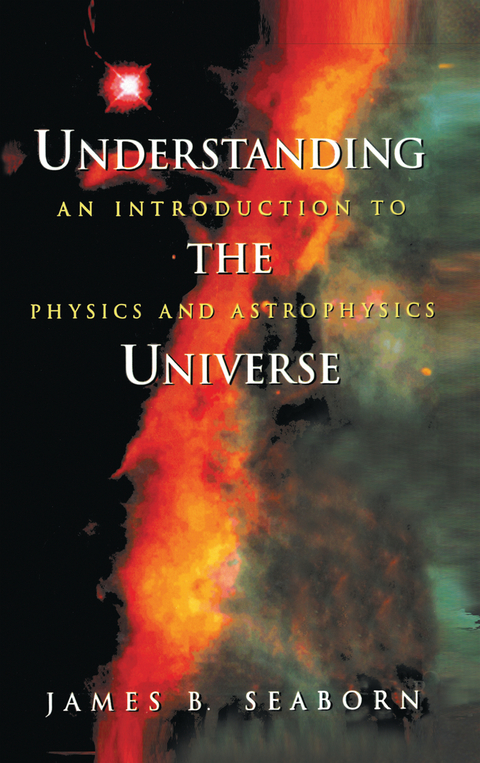
Understanding the Universe
Springer-Verlag New York Inc.
978-0-387-98295-3 (ISBN)
1. Watchers of the Heavens.- 1.1. Celestial Motions.- 1.2. Early Astronomy.- 1.3. The Copernican Revolution.- Exercises.- 2. The Stuff Moves Around.- 2.1. Fundamental Properties.- 2.2. Derived Quantities.- 2.3. Scalars and Vectors 21 Exercises.- 3. Eyes on the Skies.- 3.1. Wave Phenomena.- 3.2. Reflection and Refraction of Light.- 3.3. The Doppler Effect.- Exercises.- 4. Newton Puts It All Together.- 4.1. Newton’s Laws of Motion.- 4.2. Linear Momentum.- 4.3. Weight.- Exercises.- 5. Running the Machine.- 5.1. Mechanical Work.- 5.2. Energy.- 5.3. Collisions.- 5.4. Power.- Exercises.- 6. Off the Straight and Narrow.- 6.1. Uniform Circular Motion.- 6.2. Centripetal Force.- Exercises.- 7. The Gravity of It All.- 7.1. Early Speculations.- 7.2. Newton’s Law of Universal Gravitation.- 7.3. Measurement of the Force Constant.- 7.4. Escape Velocity.- 7.5. Planetary Atmospheres.- Exercises.- 8. Round and Round She Goes.- 8.1. Orbital Motion.- 8.2. Artificial Satellites in Earth Orbit.- Exercises.-9. As the World Turns.- 9.1. Mechanical Equilibrium.- 9.2. The Origin of the Solar System.- Exercises.- 10. Let There Be Light!.- 10.1. Electricity.- 10.2. Magnetism.- 10.3. Induced Electric Currents.- 10.4. Electromagnetic Radiation and Light.- 10.5. The Earth’s Magnetic Field.- 10.6. Electric Potential Energy.- Exercises.- 11. What’s the Matter?.- 11.1. Thomson’s Model of the Atom.- 11.2. The Discovery of Radioactivity.- 11.3. The Geiger—Marsden Experiment.- 11.4. Rutherford’s Model of the Atom.- Exercises.- 12. Hot Stuff.- 12.1. Radiation from Hot Matter.- 12.2. The Failure of Classical Physics.- 12.3. Planck’s Quantum Hypothesis.- Exercises.- 13. Einstein’s Bundles.- 13.1. The Photoelectric Effect.- 13.2. Momentum of Light.- 13.3. Equivalence of Mass and Energy.- Exercises.- 14. The Great Dane.- 14.1. The Structure of the Atom.- 14.2. The Man from Copenhagen.- 14.3. Comets.- Exercises.- 15. Sugar and Spice and Everything Nice.- 15.1. The Many-Electron Atom.- 15.2. Atomic Spectra.-15.3. The Periodic Table of the Elements.- Exercises.- 16. The Starry Messenger.- 16.1. Intrinsic Brightness.- 16.2. Stellar Spectra.- 16.3. The Hertzsprung—Russell Diagram.- 16.4. Binary Stars.- Exercises.- 17. The Sun Is a Gas.- 17.1. Boyle’s Law.- 17.2. A Molecular Model of the Gas.- 17.3. The Ideal Gas Law.- 17.4. Absolute Temperature.- Exercises.- 18. The Sun Is a Nuclear Furnace.- 18.1. The Structure of the Atomic Nucleus.- 18.2. Nuclear Reactions.- Exercises.- 19. No More to Wonder What You Are.- 19.1. The Evolution of a Star Like the Sun.- 19.2. The Evolution of a Heavier Star.- 19.3. The Stuff Between the Stars.- 19.4. Solar Neutrinos.- Exercises.- 20. The Flight of the Galaxies.- 20.1. The Nebulae.- 20.2. Variable Stars and Cosmic Distances.- 20.3. Hubble’s Discovery.- 20.4. The Structure of a Spiral Galaxy.- Exercises.- 21. The Big Picture.- 21.1. The Cosmological Principle.- 21.2. The Quasars.- 21.3. The Cosmic Background Radiation.- 21.4. A Final Word.- Exercises.- Appendix A. Linear Graphs.- Exercises.- Appendix B. Physical and Astronomical Data.- Appendix C. Useful Formulas.- Appendix D. The Chemical Elements.- Appendix E. The Brightest Stars in the Sky.
| Erscheint lt. Verlag | 12.12.1997 |
|---|---|
| Zusatzinfo | XII, 304 p. |
| Verlagsort | New York, NY |
| Sprache | englisch |
| Maße | 155 x 235 mm |
| Themenwelt | Naturwissenschaften ► Physik / Astronomie ► Allgemeines / Lexika |
| Naturwissenschaften ► Physik / Astronomie ► Astronomie / Astrophysik | |
| ISBN-10 | 0-387-98295-7 / 0387982957 |
| ISBN-13 | 978-0-387-98295-3 / 9780387982953 |
| Zustand | Neuware |
| Haben Sie eine Frage zum Produkt? |
aus dem Bereich


